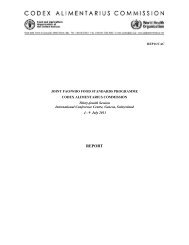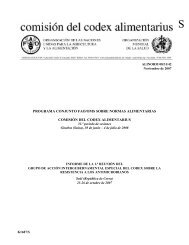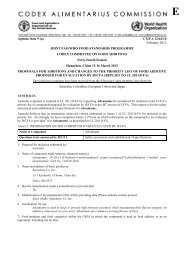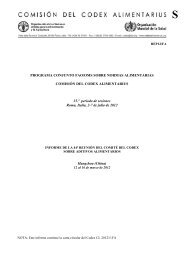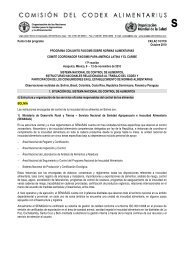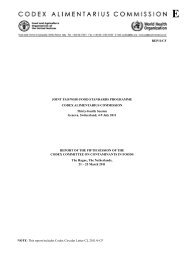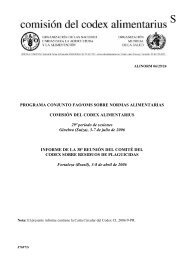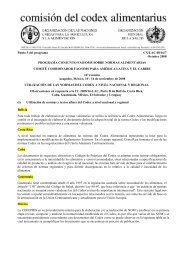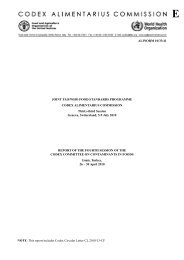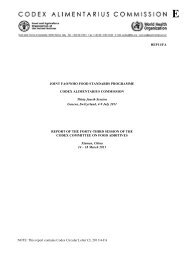Report of the 33rd Session of the Codex Committee on Nutrition and ...
Report of the 33rd Session of the Codex Committee on Nutrition and ...
Report of the 33rd Session of the Codex Committee on Nutrition and ...
- No tags were found...
Create successful ePaper yourself
Turn your PDF publications into a flip-book with our unique Google optimized e-Paper software.
REP 12/NFSDU Appendix V 55APPENDIX VPROPOSED DRAFT ANNEX TO THE CODEX GUIDELINES ON NUTRITIONLABELLING:GENERAL PRINCIPLES FOR ESTABLISHING NUTRIENT REFERENCE VALUES FORNUTRIENTS ASSOCIATED WITH RISK OF DIET-RELATED NONCOMMUNICABLEDISEASES FOR THE GENERAL POPULATION(At Step 3 <str<strong>on</strong>g>of</str<strong>on</strong>g> <str<strong>on</strong>g>the</str<strong>on</strong>g> Procedure)1. PREAMBLEThese principles apply to <str<strong>on</strong>g>the</str<strong>on</strong>g> establishment <str<strong>on</strong>g>of</str<strong>on</strong>g> <str<strong>on</strong>g>Codex</str<strong>on</strong>g> Nutrient Reference Values for labelling purposesfor nutrients associated with risk <str<strong>on</strong>g>of</str<strong>on</strong>g> diet-related n<strong>on</strong>communicable diseases (NRVs-NCD) for <str<strong>on</strong>g>the</str<strong>on</strong>g>general populati<strong>on</strong> identified as individuals older than 36 m<strong>on</strong>ths. These values may be used forhelping c<strong>on</strong>sumers 1) estimate <str<strong>on</strong>g>the</str<strong>on</strong>g> relative c<strong>on</strong>tributi<strong>on</strong> <str<strong>on</strong>g>of</str<strong>on</strong>g> individual products to overall healthfuldietary intake, <strong>and</strong> 2) as <strong>on</strong>e way to compare <str<strong>on</strong>g>the</str<strong>on</strong>g> nutrient c<strong>on</strong>tent between products. Governments areencouraged to use <str<strong>on</strong>g>the</str<strong>on</strong>g> NRVs-NCD, or alternatively, c<strong>on</strong>sider <str<strong>on</strong>g>the</str<strong>on</strong>g> suitability <str<strong>on</strong>g>of</str<strong>on</strong>g> <str<strong>on</strong>g>the</str<strong>on</strong>g> general principlesbelow <strong>and</strong> additi<strong>on</strong>al factors specific to a country or regi<strong>on</strong> in establishing <str<strong>on</strong>g>the</str<strong>on</strong>g>ir own reference valuesfor labelling purposes, for nutrients associated with diet-related n<strong>on</strong>communicable diseases.For example, at <str<strong>on</strong>g>the</str<strong>on</strong>g> nati<strong>on</strong>al level, populati<strong>on</strong>-weighted values for <str<strong>on</strong>g>the</str<strong>on</strong>g> general populati<strong>on</strong> may beestablished by weighting science-based reference values for daily intakes for age-sex groups usingcensus data for a country <strong>and</strong> proporti<strong>on</strong>s <str<strong>on</strong>g>of</str<strong>on</strong>g> each age-sex group. Governments may also c<strong>on</strong>siderwhe<str<strong>on</strong>g>the</str<strong>on</strong>g>r to establish separate food label reference values for specific segments <str<strong>on</strong>g>of</str<strong>on</strong>g> <str<strong>on</strong>g>the</str<strong>on</strong>g> generalpopulati<strong>on</strong>.2. DEFINITION(S)2.1 Nutrient Reference Values - N<strong>on</strong>communicable Disease (NRVs-NCD) refer to <str<strong>on</strong>g>Codex</str<strong>on</strong>g>nutrient reference values for food labelling purposes for nutrients that are associated with risk <str<strong>on</strong>g>of</str<strong>on</strong>g> dietrelatedn<strong>on</strong>communicable diseases not including nutrient deficiency diseases or disorders.2.2 Daily Intake Reference Values as used in <str<strong>on</strong>g>the</str<strong>on</strong>g>se principles refer to reference nutrient intakevalues provided by FAO/WHO or o<str<strong>on</strong>g>the</str<strong>on</strong>g>r recognized authoritative scientific bodies that may bec<strong>on</strong>sidered in establishing an NRV-NCD based <strong>on</strong> <str<strong>on</strong>g>the</str<strong>on</strong>g> principles <strong>and</strong> criteria in Secti<strong>on</strong> 3. Thesevalues may be expressed in different ways (e.g., as a single value or a range), <strong>and</strong> are applicable to <str<strong>on</strong>g>the</str<strong>on</strong>g>total populati<strong>on</strong> or to a segment <str<strong>on</strong>g>of</str<strong>on</strong>g> <str<strong>on</strong>g>the</str<strong>on</strong>g> populati<strong>on</strong> (e.g., recommendati<strong>on</strong>s for a specified age range).2.3 Upper Level <str<strong>on</strong>g>of</str<strong>on</strong>g> Intake (UL) 22 is <str<strong>on</strong>g>the</str<strong>on</strong>g> maximum level <str<strong>on</strong>g>of</str<strong>on</strong>g> habitual intake from all sources <str<strong>on</strong>g>of</str<strong>on</strong>g> anutrient or related substance judged to be unlikely to lead to adverse health effects in humans.2.4 Acceptable Macr<strong>on</strong>utrient Distributi<strong>on</strong> Range (AMDR) is a range <str<strong>on</strong>g>of</str<strong>on</strong>g> intakes for a particularenergy source that is associated with reduced risk <str<strong>on</strong>g>of</str<strong>on</strong>g> diet-related n<strong>on</strong>communicable diseases whileproviding adequate intakes <str<strong>on</strong>g>of</str<strong>on</strong>g> essential nutrients. For macr<strong>on</strong>utrients, <str<strong>on</strong>g>the</str<strong>on</strong>g>y are generally expressed as apercentage <str<strong>on</strong>g>of</str<strong>on</strong>g> energy intake.3. GENERAL PRINCIPLES FOR ESTABLISHING NRVs-NCD3.1 Criteria for Selecti<strong>on</strong> <str<strong>on</strong>g>of</str<strong>on</strong>g> NutrientsThe following criteria should be c<strong>on</strong>sidered in <str<strong>on</strong>g>the</str<strong>on</strong>g> selecti<strong>on</strong> <str<strong>on</strong>g>of</str<strong>on</strong>g> nutrients for <str<strong>on</strong>g>the</str<strong>on</strong>g> establishment <str<strong>on</strong>g>of</str<strong>on</strong>g>NRVs-NCD: Relevant c<strong>on</strong>vincing 23 / generally accepted 24 scientific evidence for <str<strong>on</strong>g>the</str<strong>on</strong>g> relati<strong>on</strong>ship between anutrient <strong>and</strong> n<strong>on</strong>communicable disease risk, including validated biomarkers for relevant disease risk.22Different countries may use o<str<strong>on</strong>g>the</str<strong>on</strong>g>r terms for this c<strong>on</strong>cept, for example, Tolerable Upper Nutrient Intake Level (UL) orupper end <str<strong>on</strong>g>of</str<strong>on</strong>g> safe intake range.



